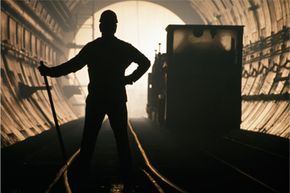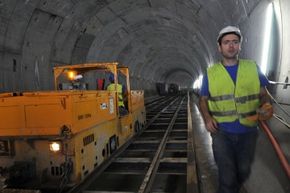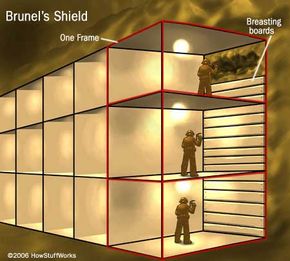
Contrary to what super villains or mole men would have you believe, it takes more than a giant machine to build an underwater tunnel.
Still, for most of our tunnel-digging history, we've managed to get by on ingenuity. Humans have tunneled since the first cave dwellers decided to excavate a spare bedroom, and the essentials of dig, support and advance were well-refined by the time the ancient Greeks used tunnels to irrigate and drain their farmland [sources: Lane; Browne].
Advertisem*nt
Underwater tunnels, too, are surprisingly old. Sometime between 2180 and 2160 BCE, the Babylonians built one of the first known examples by diverting the Euphrates River. The 3,000-foot (900-meter) brick-lined and arch-supported tunnel, which measured 12 feet high by 15 feet wide (4 meters by 5 meters), provided a pedestrian and chariot passage between the royal palace and the temple [sources: Lane; Browne].
For centuries, tunnels were employed mainly by miners and medieval sappers, who dug under castle walls to collapse them (hence the term "undermine"), but the advent of canal transport -- and, later, railroads -- gave workers something new to sink their shovels into. The 18th, 19th and 20th centuries saw a succession of ever-more challenging tunnel projects, made possible by vast improvements in surveying and ventilation techniques. Even so, danger and expense delayed attempts at underwater tunneling until the mid-1800s [source: Lane].
Which raises the question: If underwater tunneling risks digging your own grave, literally or financially, why bother? Many city planners agree, turning to tunnels only when congested bridges reach choking capacity. Yet, bridges are problematic, too. They interfere with shipping traffic, take up valuable riverfront property and block scenic views. From a defense standpoint, bridges make easy airstrike targets and can constitute hazards if they collapse [source: Hewett].
Tunnels, conversely, withstand tides, currents and storms better than bridges, can reach longer distances, and have virtually unlimited weight-carrying capacity. In addition, a tunnel's per-length cost drops as it gets longer, whereas for bridges the opposite is true. While tunnels require a larger initial investment, bridges make up the difference in maintenance costs [sources: Everglades Economics; Hewett].
But let's not get tunnel vision. There's no question that passages beneath land and sea face particular security vulnerabilities and safety issues. Fires and accidents pose dire threats in tunnels, which is why rail tunnels include crossover passages where trains can switch tracks, along with service tunnels that can serve as emergency escape routes [sources: Chan; JR-Hokkaido; WGBH].
They sound terrifying, but underwater tunnels are so commonplace that we rarely think of the great dangers -- and extreme construction techniques -- these modern wonders require.
Advertisem*nt
Contents
- Bridge (Under) Troubled Waters
- Shipworms of Unusual Size
- Letting It Sink In
- The Longest Underwater Tunnel
Bridge (Under) Troubled Waters

When digging into any extraordinary construction project, a few questions immediately poke their heads out of the sand: Which proposal ranks as the biggest, the deepest or the most hazardous to build? With underwater tunnels, these questions defy simple answers. Cities and countries constantly commission new projects. As for vital stats, the devil is between the details and the deep, blue sea.
For example, the Seikan Tunnel connecting the Japanese islands of Honshu and Hokkaido currently holds the record for the longest and the deepest underwater rail tunnel. Japan began planning it after a 1954 typhoon sank five ferry boats in the dangerous Tsugaru Strait, killing 1,430 people [sources: WGBH].
Advertisem*nt
Completed in 1988, the Seikan Tunnel stretches 33.5 miles (54 kilometers) and reaches a depth of 787 feet (240 meters), but its 14.5-mile (23.3-kilometer) undersea portion is dwarfed by that of the Channel Tunnel, or Chunnel, between the United Kingdom and France. Finished in 1994, the Chunnel's underwater portion accounts for 24 of its 31 total miles (38.6 of 50 kilometers) but plunges only 246 feet (75 meters) deep [sources: ASCE; Chan; Wise].
As far as the Turks are concerned, both tunnels are all wet compared to their $3.3-billion Marmaray Tunnel finally open to the public in 2013. Its 8.25 miles (13.2 kilometers) of railroad passage -- including a 4,600-foot (1,400-meter) stretch across the Bosporus seafloor -- connect Istanbul's Asian and European halves, making it the first rail tunnel to connect two continents [sources: Sweeney; Wise].
What's so great about a sub-mile undersea tunnel compared to the multi-mile Seikan and Channel tunnels? It's a difference of approach: Whereas its predecessors respectively blasted and bored passages through solid rock, the Marmaray Tunnel was assembled, piece by piece, in a trench along the Bosporus' bottom, which makes it the longest and deepest immersion tunnel ever built. Engineers chose this solution, which employs preassembled sections connected by thick, flexible, rubber-reinforced steel plates, to better contend with regional seismic activity [sources: JR-Hokkaido; Sweeney; Wise].
For a time, cultural and historical artifacts found throughout Istanbul's old city slowed progress on the Marmaray Tunnel excavation, so the 2.2-mile (3.6-kilometer) Øresund Tunnel connecting Sweden and Denmark remained the largest immersed-tube tunnel ever built. Contractors constructed it from 20 elements measuring 577 feet (176 meters) apiece, each assembled from eight smaller, 72-foot (22-meter) sections [sources: Landler; Marmaray Project; PERI GmbH; Sweeney].
Between immersed tunnels like Marmaray and Øresund, and bored tunnels like the Chunnel, we've just about covered the waterfront. But let's delve a little deeper into each and examine another tunneling method used since the early 19th century.
You Call That a Tunnel?
A tunnel is technically a passage dug entirely underground. Many of the subterranean tubes that we consider tunnels -- subways, sewage and water lines -- are technically conduits because they involve temporarily removing overlying materials. Tunnels are dangerous, tedious and expensive to build, so when dealing with loose dirt and relatively shallow projects, engineers often choose this cheaper and more effective cut and cover approach [sources: Lane; Hewitt].
Advertisem*nt
Shipworms of Unusual Size

The oldest approach to tunneling underwater without diverting the waters above is known as a tunneling shield, and engineers still use it today.
Shields solve a common but vexing problem, namely, how to dig a long tunnel through soft earth, especially underwater, without its leading edge collapsing [sources: Assignment Discovery; Encyclopaedia Britannica; Browne; Hewitt].
Advertisem*nt
To get a sense of how a shield works, imagine a lidless coffee tin with a sharpened bottom that sports several large holes. Now, gripping the open end, push the tin, bottom first, into some soft earth and watch how the dirt squeezes through the openings. On the scale of a real shield, several humans (nicknamed "muckers" and "sandhogs") would stand inside compartments within the "can" and remove the clay or sand as the shield advanced. Hydraulic jacks would gradually move the shield forward, while crews behind it installed metal supporting rings, then lined them with concrete or masonry [sources: Assignment Discovery]; Encyclopaedia Britannica; Browne].
In order to hold back water seepage from tunnel walls, the front of the tunnel or shield is sometimes pressurized with compressed air. Workers, who can only withstand short periods in such conditions, must pass through one or more airlocks and take precautions against pressure-related sicknesses [sources: Hewitt; Port Authority].
Shields are still used, especially when installing utility conduits or water and sewage pipes. Although labor intensive, they cost only a fraction as much as their mammoth cousins, the tunnel boring machines (TBMs) [sources: Assignment Discovery; Encyclopaedia Britannica; WGBH].
A TBM is a multistory-tall engine of destruction capable of chewing through solid rock. At its front spins a cutting head, a giant wheel that bristles with rock-breaking disks and incorporates a system of scoops to lift pummeled rock and drop it onto an outbound conveyor belt. Behind the cutting head swings an erector, a rotating assembly that builds the tunnel lining in the TBM's wake. In some large projects, like the Chunnel, separate TBMs will begin on opposite ends and drill toward a central point, using sophisticated surveying methods to keep them on course [sources: Assignment Discovery; Coleman et al.; WGBH].
Drilling through solid rock creates a largely self-supporting tunnel, and TBMs drive forward quickly and relentlessly (some Chunnel machines could bore 250 feet, or 76 meters, per day). On the down side, TBMs break down more often than a used Jaguar and deal poorly with worn, sheared or highly jointed rock -- so they aren't as fast as they're cracked up to be [sources: WGBH; WGBH].
Luckily, TBMs and shields aren't the only game in town.
Brunel's Breakthrough
The tunneling shield was invented by engineer Marc Isambard Brunel, who was inspired by watching a shipworm (a marine bivalve) drive its shell plates through wood and eject sawdust in its wake. Using his device, he successfully dug a tunnel under London's Thames River from 1825 to 1843, enduring two breakthrough floods and a seven-year shutdown when the project's cash flow dried up. Brunel and his son spent nearly every waking hour in the tunnel, often forced to work from a boat. The strain reportedly led to his death a few years later [sources: Assignment Discovery; Encyclopaedia Britannica; Browne; Hewitt].
Advertisem*nt
Letting It Sink In
Constructing a steel-and-masonry support while simultaneously digging through soft earth or solid rock is no picnic, but trying to hold back a sea while underwater is something not even Moses would have attempted. Fortunately, thanks to American engineer W.J. Wilgus and his invention, the sunken- or immersed-tube tunnel (ITT), we don't have to [source: Lane].
ITTs aren't bored through rock or soil; they are assembled on-site from football-field-sized, prefabricated pieces. Wilgus pioneered the technique when he built the Detroit River railroad tunnel (1906-10) connecting Detroit, Mich., to Windsor, Ont., and they've been the go-to technique for vehicle tunnels ever since. Indeed, more than 100 such tunnels were built in the 20th century alone [sources: Lane; Extreme Engineering; Marmaray Project].
Advertisem*nt
To make each tunnel segment, workers assemble 30,000 tons of steel and concrete -- enough for a 10-story apartment building -- in a massive mold, then allow the concrete to cure for nearly a month. The molds contain the tunnel's floor, walls and ceiling, and are initially capped at the ends to keep them watertight as they are transported out to sea. Immersion pontoons, large ships resembling a cross between a gantry crane and a pontoon boat, do the hauling [sources: Lane; Extreme Engineering; Marmaray Project].
Once over the pre-dug sea trench, each tunnel section is flooded enough to allow it to sink. A crane slowly lowers the section into position while divers guide it precisely to its GPS coordinates. As each new section connects to its predecessor, a massive rubber piece on its end squeezes and distends to establish a seal. Crews then remove the bulkhead seals and pump out the remaining water. Once the entire tunnel is built, it is buried under backfill and possibly covered with rock armor [sources: Lane; Extreme Engineering; Marmaray Project].
Immersed-tube construction can delve deeper than other approaches because the technique does not require compressed air to hold water at bay. Crews can therefore work longer in them and under more tolerable conditions. Moreover, an ITT can take any form, unlike a bored tunnel, which follows the shape of its shield or TBM. However, because ITTs only make up the seafloor or riverbed portion of a tunnel system, they require other tunneling methods to bore their land-based entrances and exits [sources: Lane; Marmaray Project; WGBH]. In underwater tunneling, as in life, it takes all kinds.
Advertisem*nt
The Longest Underwater Tunnel
The title for the longest underwater tunnel has been hard fought. But, Norway has big plans to put the debate to rest for good with the the Norwegian Coastal Highway Tunnel [source: TunnelBuilder].
This colossal vehicular tunnel is expected to be completed in the 2030s and is set to redefine the benchmarks of underwater tunneling. Norway, with its rugged coastline and deep fjords, has always posed a challenge for connectivity. The Coastal Highway Tunnel aims to replace ferry services and bridge the physical gaps, facilitating a continuous route along the western coast.
Advertisem*nt
Envisioned to be over 27 kilometers long, the tunnel will surpass current records, diving under the Norwegian Sea, and reaching depths of approximately 390 meters below sea level, it represents the pinnacle of underwater tunnel construction.
The planning and design of this monumental structure required groundbreaking innovation. Unlike traditional bored or immersed-tube tunnels, the Norwegian engineers are pioneering the use of submerged floating tunnels, a first of its kind.
These tunnels, consisting of tube sections that float underwater, supported by pontoons and anchored firmly to the seabed, offer a novel solution to the challenges of deep-sea tunneling. This method not only circumvents the difficulties of drilling through the tough subsea bedrock but also withstands the pressure and the harsh conditions of the Norwegian Sea.
If all goes according to plan, the Coastal Highway Tunnel may one day stand as the longest tunnel in the world. Its completion will mark a new era for Norway and for the world of civil engineering, as it stands as a silent, sturdy sentinel beneath the waves, a submerged triumph over the tumultuous sea.
A Trans-Atlantic Tunnel: Yippee or Yikes?
Were we to attempt the long-dreamed trans-Atlantic tunnel, a floating immersion tube, tethered at an ideal depth of 150 feet (45.7 meters) by tension-adjustable cables, would be the likely approach. Of course, such an undertaking would require an estimated 54,000 football-field-sized sections, using the equivalent of one year's global steel output and 225 concrete factories functioning at capacity 24 hours a day for 20 years. That's before you get to the trillions of dollars, thousands of workers, and numerous robots and submarines it would take to build under dangerous open sea conditions, to say nothing of safety issues posed by marine traffic and seismic events [sources: Extreme Engineering; Extreme Engineering; Harrison].
Advertisem*nt
Lots More Information
Author's Note: How do you build an underwater tunnel?
In writing this article, I could only touch on the basics of constructing underwater tunnels, which is an injustice comparable to equating defusing a bomb with programming a DVR. In reality, the dangers involved and the precision required in constructing an underwater tunnel are simply staggering. Excavating and constructing these modern marvels requires nothing short of constant vigilance, keen adaptability and minute adjustments to changing conditions, to say nothing of the care that workers and divers must exercise.
It's something worth thinking about the next time you find yourself traveling through an underwater tunnel. Perhaps it will distract you from the millions of tons of earth or water pressing down or, if you are in Japan's Seikan Tunnel, from the sound of water tinkling in through the walls to be drained by the pumps at 20 tons per minute.
Related Articles
- How Subways Work
- How Tunnels Work
- How Underground Mining Works
- What would happen if I drilled a tunnel through the center of the Earth and jumped into it?
Sources
- American Society of Civil Engineers. "Seikan Tunnel." http://www.asce.org/Featured-Images/Seikan-Tunnel/
- Assignment Discovery. "Shield Tunneling." https://videos.howstuffworks.com/discovery/29896-assignment-discovery-shield-tunneling-video.htm
- Assignment Discovery. "Tunnel Boring Machines." https://videos.howstuffworks.com/discovery/36684-mega-engineering-tunnel-boring-machines-video.htm
- Browne, Malcolm. "Tunnel Drilling, Old as Babylon, Now Becomes Safer." The New York Times. Dec. 2, 1990. http://www.nytimes.com/1990/12/02/world/tunnel-drilling-old-as-babylon-now-becomes-safer.html
- Chan, Sewell. "Who's Watching the Underwater Tunnels?" The New York Times. July 20, 2005. http://www.nytimes.com/2005/07/20/nyregion/20tunnels.html?pagewanted=1&_r=0&sq&st=cse%22%22Immersed%20tube&scp=4
- Encyclopaedia Britannica. "Sea of Marmara." http://www.britannica.com/EBchecked/topic/365921/Sea-of-Marmara
- Encyclopaedia Britannica. "Tunneling Shield." http://www.britannica.com/EBchecked/topic/609360/tunneling-shield
- Everglades Economics. "Comparing Costs of Options for Reconstructing the 12th and 27th Avenue Bridges Over the Miami River." Miami River Commission. February 2003. http://www.miamirivercommission.org/PDF/tunnel%20study.pdf
- Extreme Engineering. "Building an Immersed Tunnel." https://videos.howstuffworks.com/discovery/29855-extreme-engineering-building-an-immersed-tunnel-video.htm
- Extreme Engineering. "Finishing the Immersed Tunnel." https://videos.howstuffworks.com/discovery/29853-extreme-engineering-finishing-the-immersed-tunnel-video.htm
- Extreme Engineering. "Transatlantic Tunnel Design." https://videos.howstuffworks.com/discovery/29150-extreme-engineering-transatlantic-tunnel-design-video.htm
- Harrison, Harry. "A Transatlantic Tunnel, Hurrah!" Pinnacle Books. 1972.
- Hewett, Bertram Henry. "Shield and Compressed Air Tunneling." McGraw-Hill. 1922.
- JR-Hokkaido Hakodate Branch. "Seikan Tunnel." http://jr.hakodate.jp/global/english/train/tunnel/default.htm
- Landler, Mark. "A Subway Bores Into the Ottoman and Byzantine Eras." The New York Times. Aug. 2, 2005. http://www.nytimes.com/2005/08/02/international/europe/02istanbul.html?pagewanted=print&_r=0
- Lane, Kenneth S. "Tunnels and Underground Excavations." Encyclopaedia Britannica. http://www.britannica.com/EBchecked/topic/609297/tunnels-and-underground-excavations#toc72433
- Marmaray Project. "The Immersed Tube Tunnel." 2003. http://www.marmaray.com/html/tech_immersed.html
- Port Authority of New York and New Jersey. "Lincoln Tunnel: History." http://www.panynj.gov/bridges-tunnels/lincoln-tunnel-history.html
- Sweeney, Chris. "The World's 18 Strangest Tunnels." Popular Mechanics. http://www.popularmechanics.com/technology/engineering/architecture/4343590#slide-1
- WGBH Educational Foundation. "Channel Tunnel (Chunnel)." PBS. http://www.pbs.org/wgbh/buildingbig/wonder/structure/channel.html
- WGBH Educational Foundation. "Seikan Tunnel." PBS. http://www.pbs.org/wgbh/buildingbig/wonder/structure/seikan.html
- WGBH Educational Foundation. "Tunnel Basics." PBS. http://www.pbs.org/wgbh/buildingbig/tunnel/basics.html
- Wise, Jeff. "Turkey Building the World's Deepest Immersed Tube Tunnel." Popular Mechanics. Oct. 1, 2009. http://www.popularmechanics.com/technology/engineering/4217338